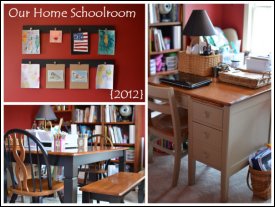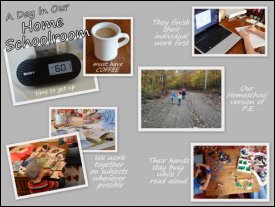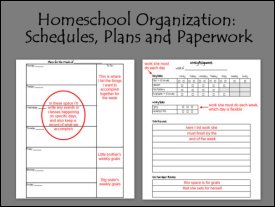10 Crafts to Encourage Creativity in Kids
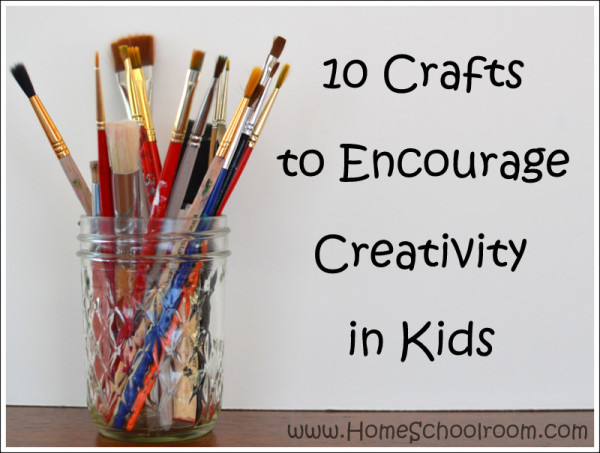
The topic for this week’s iHomeschool Network Top Ten Tuesday is toys! Why am I talking about crafts, you ask? Well, my children are by no means short on toys but I hate the clutter and single-purpose types of toys that fill the shelves these days. Toys that support open-ended play like Legos and puppets are the only toys I don’t try to sneak into the yard sale pile. Something I love to see my children use their free time for is creating something.
I have always enjoyed crafting, so I’ve kept a craft cupboard stocked with supplies my kids can use since they were preschoolers. I don’t like to have them always following my (or someone else’s) exact directions to arrive at a prescribed end product, but I’ve found that when introducing craft supplies it helps if we work together at first, or I provide a book or video with instructions for their first project or two. Once they get their feet wet they’re ready to branch out on their own and create to their heart’s content.
Here’s my list of 10 types of craft supplies to keep on hand for creative inspiration:
#1 Drawing Supplies
Drawing may be the simplest craft, but having some extra supplies on hand makes it a little more interesting. I stock mechanical pencils, colored pencils and fun drawing tools like actual drawing pencils that make shading easier, pens of different thicknesses for line drawings, and gel pens for fun. Invest in some how-to-draw books for instruction and inspiration. What is nice is that you can find how-to books for just about any interest your child has (for my son it was military vehicles). Chalk pastels are as simple to use as crayons with a lot more ability to mix and blend. Tricia at Hodgepodge posts wonderful pastel lessons to get you started.
#2 Painting Supplies
Each of my children uses one of Daddy’s old shirts as a smock and I stock various types of paints:
- Watercolor: Tray and liquid watercolors are both fun. With watercolor pencils your child can use them like regular colored pencils then use a wet brush to blend. With any watercolors it’s best to use a heavier-weight paper. Sometimes we just use white cardstock, but other times we break out the real watercolor paper. (Kids love using grown-up supplies.) Klutz has a nice beginner watercolor book that teaches some beginning strokes.
- Tempera: I buy the washable kind and it’s great for thick coverage on paper.
- Acrylic: I stock up on different colors when they’re on sale. We use acrylic if we’re painting on something other than paper: wood, cardboard, rocks, you name it!
- Don’t forget specialty paints: We’ve made great gifts for grandparents out of plain mugs, coasters, place mats and tote bags using glass/ceramic, metal and fabric paints.
#3 Sculpting Supplies
Don’t let the fancy term frighten you, there are many options to try that aren’t difficult. First off there is gold old homemade playdough. I’ve shared our personal favorite recipe before, and I must say my son still plays with it most days. He reenacts battle scenes from our history studies or runs trials with his creations (he’s a big fan of Mythbusters right now).
If your children want to keep their creations there are two great options:
- Air Dry Clay: We’ve used air dry clay during history studies to make candle holders. It’s easy to mold and you simply leave it out to dry. After drying it can be painted.
- Sculpey Polymer Clay: This is one of our all-time favorite craft supplies. It comes in loads of colors (or buy white and paint it after it’s baked). It’s a little difficult to soften when you first start, but using a little muscle it’s easy to sculpt. After the creation is finished you bake it in the oven to harden it. My daughter uses Sculpey to make food and accessories for her Victorian doll house.
#4 Duct Tape Crafting
Just about every kid enjoys crafting with duct tape. As an independent craft your kids should be a little older because you have to use a sharp knife to cut the tape. We use a self-healing fabric cutting mat as a work surface. The book Tape It and Make It helped my daughter with basic construction skills and some cute projects to get started.
#5 Stamping Supplies
My son doesn’t always enjoy drawing so stamping is one of his favorites. From his own rubber stamps of vehicles and bugs, to sets I’ve bought with letters and holiday images, he has fun using them to make pictures and cards for people. I buy washable stamp pads for using with rubber stamps and it’s also fun to use them with your fingers like Ed Emberly to make pictures.
#6 Card Making Supplies
I purchase packs of blank cards and envelopes at the craft store. (I use a coupon or wait for them to be on sale then buy a pack of 25 or 50.) I keep lots of supplies on hand for decorating: fancy edge scissors, paper punches (the that work almost like scissors are easiest for their hands), colored card stock, and of course they can use our other supplies like paints, gel pens, and rubber stamps to decorate them. I lay out the supplies after Christmas and birthdays and have them create their own thank you cards.
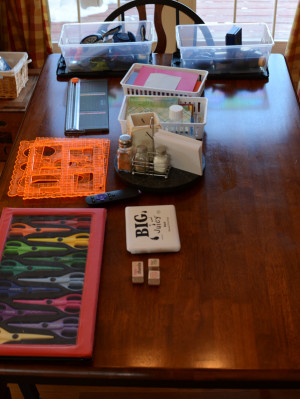
#7 Recyclables!
In our basement I keep a large cardboard box where I throw things that would normally go in our recycling that my kids are free to use any way they wish. Egg cartons, oatmeal canisters, orange crates, glass jars, bottle caps, shoe boxes, cardboard tubes (I prefer ones stronger than paper towel tubes–like the ones from plastic wrap and aluminum foil), and any other odds and ends that look promising. They build all sorts of things and I don’t have to worry about overseeing what supplies are being used.
#8 Sewing Supplies
Don’t be turned off just because you don’t sew! I have two easy recommendations to get you started.
- One is a superb book called Sewing School. It is filled with wonderfully easy to understand instructions that will help your child with the very basics (like threading a needle and the simplest stitch) and includes instructions for kid-friendly sewing projects with patterns included in a pocket in the back.
- The other tip I have is to keep sheets of craft felt on hand. You can buy sheets of craft felt very cheaply, it comes in a rainbow of colors, and it’s great for beginning sewers. I keep a bin of it that the kids can cut shapes out of and sew together using craft thread and a large needle. They make little creatures, blankets and pillows for dolls and stuffed animals, and anything else they can think of. Because it’s inexpensive they’re free to try to make things (even if the project doesn’t work out) and they don’t have to worry about the edges fraying like fabric.
#9 Odds and Ends
This is my category for all those random supplies you can pick up and wonder what they could be used for–but don’t worry, your kids will make them into something! Keep your eye out for inexpensive bags of popsicle sticks, googly eyes, pipe cleaners, yarn, old-fashioned style wooden clothespins, feathers, and pom poms.
#10 All-in-One Craft Kits
All-in-one kits are great to have on hand (and give as gifts). We’re big Klutz fans and my kids have enjoyed projects like paper airplanes, friendship bracelets, Twirled Paper (Quilling), and Twisted Critters (Pipe Cleaner Animals). These kits are especially great for craft-challenged households because they’re really designed for the kids to do on their own and come with all necessary supplies.
I hope I’ve persuaded you to stock your craft cupboard if you don’t already. Now is the perfect time so you can just point the way for a sure summer boredom buster! What do you keep on hand for those moments when the urge to create strikes your kids?
Hop over to iHomeschool network to see what toys make other blogger’s top ten lists.
{Every Tuesday for the next 10 weeks I’ll be participating in a blog hop of top ten lists.}
This blog hop series was inspired by Angie of Many Little Blessings where you’re welcome to link up, too!


 Hi, I'm Heidi and I homeschool my two sweet kids. I want them to know that learning is an exciting lifelong adventure! We love great books, unit studies, notebooking, lapbooking, and hands-on learning.
Hi, I'm Heidi and I homeschool my two sweet kids. I want them to know that learning is an exciting lifelong adventure! We love great books, unit studies, notebooking, lapbooking, and hands-on learning.